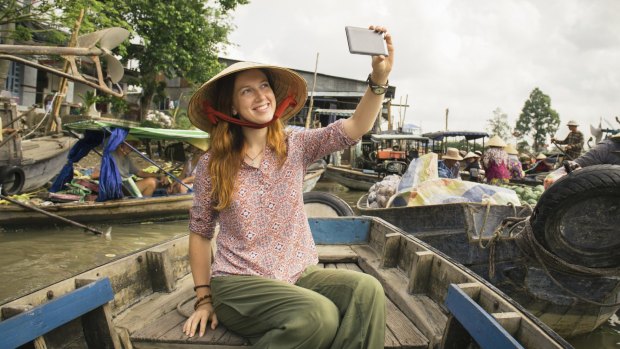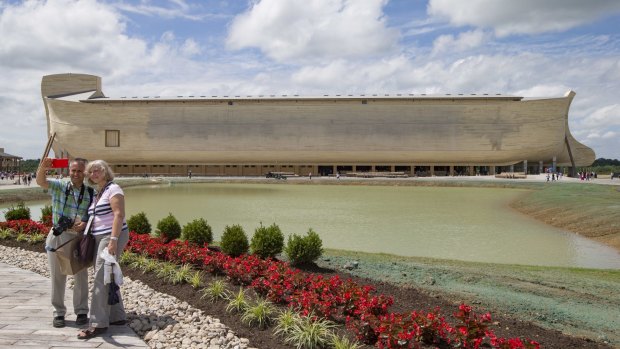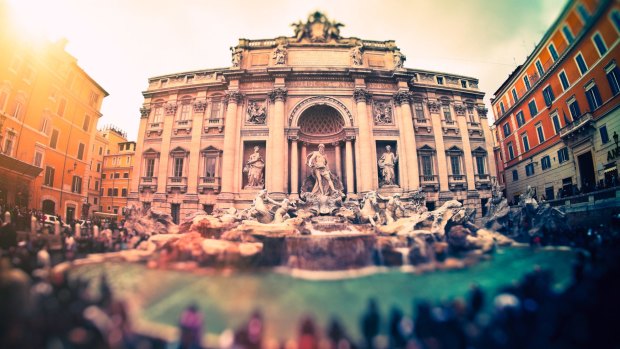This was published 7 years ago
Travel essay: Selfies - are they ruining travel?
By Ute Junker

A shot to capture the moment: Cai Rang floating market, Can Tho, Vietnam.Credit: iStock
Visiting the Trevi Fountain these days can feel uncannily like attending a rock concert. Not just the Trevi Fountain, of course: front up to any of the world's most popular sights, from Buckingham Palace to Old Faithful, and you will find that your view is obscured by a forest of outstretched arms, brandishing camera phones instead of cigarette lighters.
The camera phone has become an unavoidable part of the travel experience, one that is both a blessing and a curse, depending on who is wielding it. You and I are sensible people who use our camera phones as a convenient tool for capturing essential memories of our travels. Those people over there, however, are irresponsible narcissists who are less interested in exploring a destination than in uploading endless images of themselves in exotic climes.
There are plenty of travellers ready to sound off on the topic of how the selfie circus is destroying the whole travel experience. Selfie snappers don't even bother setting foot inside monuments half the time, we are told; once they've snapped a suitably sexy shot, they simply move on the next monument. Grand castles, mighty glaciers, ancient ruins and scenic villages – all are reduced to providing backdrops for "panda travellers", the type that shoots, tweets and leaves.

There's no age limit for selfies: Visitors take a selfie as a replica Noah's Ark stands in the distance at the Ark Encounter theme park in Williamstown, US.Credit: John Minchillo
Personally, I am sceptical of this argument, which tends to be long on invective and short on facts. Photography has been an essential part of the travel experience since the advent of affordable cameras. Who hasn't reached for a camera to preserve a pinch-yourself moment in a far-distant land? Would anyone really go to the Taj Mahal and not take a photo? The Grand Canyon? On safari? And once you have a photo, of course you want to show it off. Isn't posting a pic to Instagram just the 21st century version of inviting friends and family over for a slide night?
I'm not the only one who refuses to join the condemnation. At least one senior travel figure argues that posting photos on social media has brought big benefits for the travel industry. According to Sue Badyari of World Expeditions, all those selfies posted by snap-happy travellers are broadening our collective travel horizons. Badyari has seen a surge of sales in big-ticket adventure trips such as the Inca Trail, the Great Wall Trek, the Kilimanjaro Climb or the trek to Everest Base camp – driven, she says, by images posted on social media.
"People read blogs, watch videos and look at stunning images from Instagram from these adventures and they think, 'Gosh, I'd like to do that'," says Badyari. "That perpetuates more growth for those type of trips."

Popular sights such as the Trevi Fountain, Rome, attract tourists and selfie-takers.Credit: Getty Images
Destinations closer to home have also benefited from selfie fever. Rottnest Island, a day trip destination from Perth, has seen a boom in visitation thanks to a social media campaign encouraging visitors to take a selfie with one of the island's friendly quokkas. The island has seen a 6 per cent spike in visitor numbers since the campaign was launched.
Not every destination is rolling out the carpet for selfie snappers, however. In Mumbai, an epidemic of selfie deaths prompted Mumbai's local government to declare 16 selfie-free zones, the Washington Post reported this year. That followed a spate of 19 selfie-related fatalities, including three students who stopped for a selfie in front of an oncoming train.
The phenomenon is not limited to Mumbai. Similar accidents have happened around the world, including a 17-year-old Russian girl who died falling from a St Petersburg bridge and a 21-year-old Spanish man who died trying to take a selfie atop a train. However, Mumbai is the first place to have introduced such legislation, with fines of 1200 rupees ($24) levied on anyone who steps into the no-go zones, which are principally scenic coastal spots.
You can't help thinking that what Mumbai is really trying to do is outlaw stupidity. Good luck with that. However, if their legislation does seem to work, perhaps we could have a go at outlawing bad manners next. One of the main reasons selfie snappers aggravate their fellow travellers, after all, is their tendency to get in the way. It's a problem that has existed ever since cameras became affordable, but that stretched-arm pose adopted by selfie snappers does intrude further into other people's space than more traditional photo-snapping stances.
However, this is merely a symptom of a much larger problem, according to travel photographer Richard I'Anson: the need for better camera etiquette across the board. I'Anson, who leads photography trips to various countries, notes that many people seem to assume that holding a camera gives them a licence to intrude.
"The idea of photography ethics is something I talk about on my photography trips," he says. "As a photographer, I try to do what I do as discreetly as I can; I know I'm intruding on people's privacy. We have to be aware and we have to be sensitive and treat people with dignity."
Again, this is hardly a new phenomenon. Photography has always involved a power imbalance between the photographer and the subject. Indeed, in the earliest days of the art form, photographers wielded their power so flagrantly that it verged on abuse.
Take Maxime Du Camp, the man behind what was probably the world's first coffee table travel book. Accompanied by one of his friends – a then-unknown writer called Gustave Flaubert – Du Camp took a trip through Egypt and Syria in 1849. Du Camp recorded their travels using an early Calotype camera, and the photographs featured in a book that was published upon his return.
In those days, photography required long exposures, which made street scenes impossible to capture. Instead, Du Camp focused his camera on the area's ancient relics. To give a sense of scale of the massive monuments, Du Camp included the figure of a man in many of his photos. In one shot, for instance, the man – a servant of Du Camp's, called Hadji-Ishmael – stands next to the carving of a pharaoh's face, his entire body about the same length as the pharaoh's nose.
To modern eyes, it is outrageous to see someone carelessly clambering over these ancient statues. Even more outrageous, however, is the method that Du Camp used to ensure Hadji Ishmael stood still long enough for the exposure to be captured.
"The great difficulty was to get Hadji-Ishmael to stay perfectly motionless while I performed my operations; and I finally managed it be means of a trick," Du Camp wrote. "I told him that the brass tube of the lens jutting from the camera was a cannon, which would vomit a hail of shot if he had the misfortune to move – a story which immobilised him completely, as can be seen from my plates."
It wouldn't happen today, of course. In fact, as camera phones are becoming increasingly affordable even in developing nations, these days the locals are sometimes as keen to photograph tourists as the tourists are to photograph them. The ghost of Hadji-Ishmael would be amused, I think, at the way the tables have turned.
A flick through Du Camp's photos also reminds us of one overlooked aspect of social media: the amount of creativity it has encouraged. The cumbersome technology available to Du Camp limited his options for taking interesting photographs. Today's digital hand-held devices, by contrast, give us the freedom to literally look at a destination from a different angle. A quick scroll through Instagram reveals the inventiveness of amateur photographers, inspired by the endless array of images they see online.
For every straight-up travel selfie, there are dozens of shots capturing unusual angles or telling details: from finely carved window frames to hennaed hands, mist-wrapped trees to elongated shadows thrown into relief by brightly-coloured walls. It's clear that, for some travellers at least, their camera phone has tapped into an unexpected vein of creativity.
There is another aspect of the rise of the travel selfie phenomenon that is often overlooked. One of the reasons that they have taken off, I think, is because other souvenirs have largely lost their lustre. We used to eagerly carry home exotic items from our travels: carved jade from China, camel hair caps from Morocco, carpets from Iran. In today's globalised world, these hard-to-get items have lost their mystique. Chances are, the store down the road stocks something similar; if not, you can always order it over the internet. The glamour-backdrop selfie has taken over as the way to prove your status as an experienced traveller.
However, it's worth remembering that both selfies and souvenirs are, in some ways, a distraction. Travel is not just about what you see and do in a destination; it's about the impact the destination has on you. Take, for instance, Du Camp's travelling companion, Gustave Flaubert. For the young writer, the Middle East was a revelation, its streets full of colour, noise and movement.
"There was the most astounding racket, sticks thrashing out to left and right, every blow augmented by ear-splitting guttural exclamations," Flaubert wrote in one of his descriptions. "I gobbled up a bellyful of colour, like a donkey filling himself with oats."
He also gobbled up plenty of souvenirs, only some of which survived the journey home. The gazelle skins were eaten by worms en route; the embalmed Nubian crocodile fared better, as did piles of embroidered wool and silk from Beirut.
Far more precious than these keepsakes, however, were the impressions of exotic lands that Flaubert carried inside his head. These seductive images of the east that were to resurface repeatedly in his novels. From Madame Bovary to Salammbo, Flaubert's books were shaped by his travels. For ultimately, destinations work on us like Nietzsche's abyss: even as we try to capture them with a camera, they are also capturing us.
Sign up for the Traveller newsletter
The latest travel news, tips and inspiration delivered to your inbox. Sign up now.